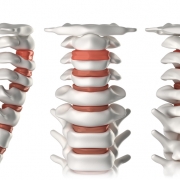 Cervical total disc replacement (CTDR) has been used as an alternative to fusion surgery much more in recent years. During a trial for the Prodisc-C [Synthes Spine] total disc replacement (TDR) in 2006, patient satisfaction was reported as high as 70 to 85 percent, and evidence indicated the CTDR procedure improved motion preservation more than fusion surgery.
Cervical total disc replacement (CTDR) has been used as an alternative to fusion surgery much more in recent years. During a trial for the Prodisc-C [Synthes Spine] total disc replacement (TDR) in 2006, patient satisfaction was reported as high as 70 to 85 percent, and evidence indicated the CTDR procedure improved motion preservation more than fusion surgery.
In some cases, this theory still holds true today. Determining whether or not CTDR is the best surgical option for you depends on your medical history and current pain symptoms. Dr. Mark Giovanini at NeuroMicroSpine evaluates every patient to determine the best possible option, and often recommends CTDR for improving neck and arm pain if there isn’t a history of joint infection/disease and/or osteoporosis.
When deciding between the two surgical procedures (cervical fusion and CTDR), Dr. Mark Giovanini thoroughly examines a patient to determine whether or not they’re suffering from cervical disc disease. Cervical disc disease is typically caused by an abnormality in one or more discs that lie between the neck bones (vertebrae). When a disc in the vertebrae is damaged, it can lead to neck pain, inflammation and numbness in the arms.
Cervical fusion and CTDR are two ways a surgeon can restore the spine to its original height after the diseased disc has been removed. Patients who receive CTDR are usually able to return to work much quicker then those who undergo a cervical fusion. CTDR does take a little longer to perform and increases the possibility of more blood loss; regardless, the procedure provides patients with more options post-op, should the patient need additional surgery down the road.
The same does not go for patients receiving a cervical fusion. Unfortunately it is not possible to put an artificial disc where a cervical fusion occurred. As mentioned previously, not every patient is a candidate for CTDR—those with osteoporosis, joint diseases and infections, and significant inflammation, are not likely candidates for the procedure.
If you’re suffering from pretty significant neck pain, consider scheduling a consultation with Dr. Giovanini.
For more information on minimally invasive spine surgery or to make an appointment with Dr. Giovanini, please call (850) 934-7545 or visit http://www.neuromicrospine.com/request-appointment. We hope to see you soon!
The advice and information contained in this article is for educational purposes only, and is not intended to replace or counter a physician’s advice or judgment. Please always consult your physician before taking any advice learned here or in any other educational medical material.
© NeuroMicroSpine, 2014
© Medical Marketing Solutions, 2014
